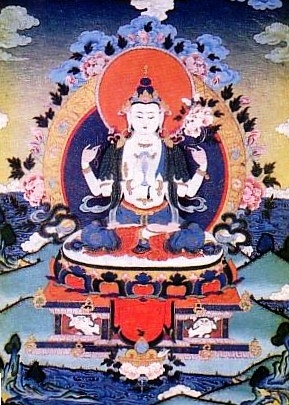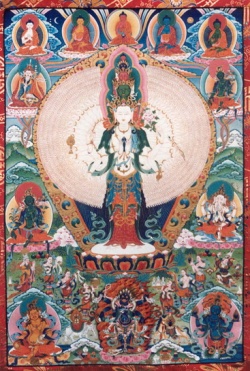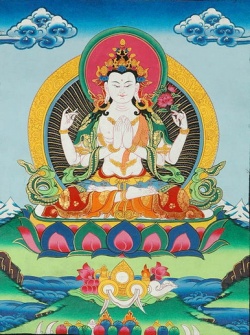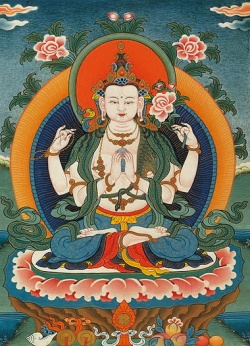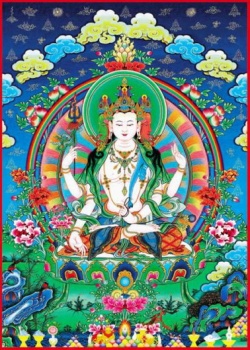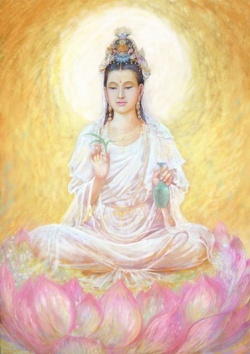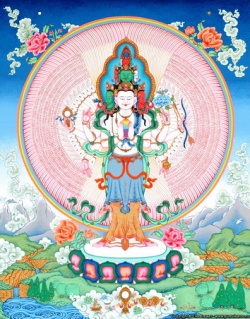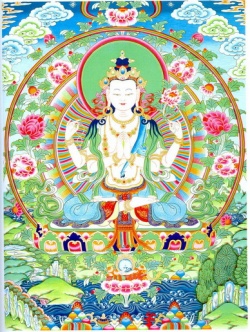Avalokiteshvara
- See also :
- See also :
Avalokiteshvara (Skt. Avalokiteśvara; Tib. སྤྱན་རས་གཟིགས་, Chenrezik; Wyl. spyan ras gzigs or spyan ras gzigs dbang phyug) is said to be the essence of the speech of all the buddhas and incarnation of their compassion.
As one of the Eight Great Close Sons, he is usually depicted as white in colour and holding a lotus.
He is of special importance to Tibetans, so much so that he is sometimes described as the patron deity of Tibet.
Among his emanations are King Songtsen Gampo — who is credited with authoring the Mani Kabum, a cycle of teachings and practices dedicated to the deity — as well as the lineages of Dalai Lamas and Karmapas.
Forms
Masculine Forms
One Face and Two Arms
- Lokanatha (Tib. འཇིག་རྟེན་མགོན་པོ་, Wyl. 'jig rten mgon po)
- Khasarpana or Khasarpani
- Padmanarteshvara (Tib. པདྨ་གར་གྱི་དབང་ཕྱུག་, Wyl. padma gar gyi dbang phyug)
- Nilakhanta
- Padmapani
- Simhanada (Tib. སེང་གེ་ང་རོ་, Wyl. seng ge nga ro)
- Tailokyavashamkara
- Vajradharma (Tib. རྡོ་རྗེ་ཆོས་, Wyl. rdo rje chos)
One Face and Four Arms
- Chaturbhuja
- Jinasagara (Tib. རྒྱལ་བ་རྒྱ་མཚོ་, Wyl. rgyal ba rgya mtsho)
- Shadakshrilokeshvara (Tib. སྤྱན་རས་གཟིགས་ཕྱག་བཞི་པ་, Wyl. spyan ras gzigs phyag bzhi pa)
- Rakta Lokeshvara
One Face and Eight Arms
- Amoghapasha (Tib. དོན་ཤགས་, Wyl. don shags)
Three Faces
- Chintachakra
Eleven Faces
- Ekadashamukha (Tib. བཅུ་གཅིག་ཞལ་, Wyl. bcu gcig zhal)
- Sahasrabhujalokeshvara (Tib. ཕྱག་སྟོང་ཞལ་བཅུ་གཅིག་, Wyl. phyag stong zhal bcu gcig)
- Vajragarbha
Feminine Forms
Further Reading
- Bokar Rinpoche, Chenrezig, the Lord of Love (San Francisco: Clearpoint Press, 1991)
- Jamgön Mipham, A Garland of Jewels, trans. by Lama Yeshe Gyamtso (Woodstock: KTD Publications, 2008)
- John Blofeld, Bodhisattva of Compassion—The Mystical Tradition of Kuan Yin (Boston: Shambhala, 1988)
- Tulku Thondup, The Healing Power of the Mind (Boston: Shambhala, 1998), 'Invoking the Buddha of Compassion to Open Our Hearts' in chapter 15.
See Also
External Links
Source
The name is a compound of Ishwara, meaning Lord, and avalokita, looked upon or seen, and is usually translated as the Lord Who Observes (the cries of the world);
the Buddhist embodiment of compassion as formulated in the Mahayana Dharma. Also called Kuan Yin, the Bodhisattva of Compassion.
Guan Yin is one of the triad of Amitabha Buddha, represented on his left, Usually recognizable by the small Buddha adorning Her crown. Guan Yin can transform into many different forms in order to cross over to the beings. Guan Yin is one of the most popular Bodhisattva in China.
Popularly known as the Bodhisattva of Compassion. He has reincarnated in this world numerous times (in both male and female forms) and therefore plays many roles depending on which strand of Buddhism one follows.
First, in Mahayana Buddhism, he is considered to be the manifestation of Amitabha Buddha, the founder of the Pure Land school of Buddhism, and is often represented at Amitabhas right hand. As such he is available to help all in dire need. Second, in China, she appears as Kuan Yin, the Goddess of Compassion.
In folk belief, she keeps people safe from natural catastrophe.
Third, in Tibet, he appears in several forms. The most important of these are as Chenrezig (the male partner of the couple who gave birth to the Tibetan people), Tara, and as the Dalai Lama.
Compassionate bodhisattva who is described in the Land of Bliss sutras as standing by the side of Amida to welcome the deceased to the afterlife. In China, Avaoliteshvara became a feminine deity, Kuan yin.
Mahayana Bodhisattva of Compassion
Also: Avoliciteshwara (other transcription) Chenrezi (tib), Janraisig, Ariyabalo? (mon). The most important mantra "Om Mani Bad Me Hom" is dedicated to this deity. The Dalai Lama is supposed to be a reincarnation of this deity.
In Tibet he would also be known as Spyan ras gzigs (With a Pitying Look) and in Mongolia as Nidu ber ujegci (He Who Looks With the Eyes).
He is the only Mahayana Buddhist deity commonly worshipped in Theravada (Way of the Elders) countries that base their worship on the Pali canon and do not normally recognize the concept of bodhisattvas.
In Sri Lanka he is known as Natha deva (often mistakenly confused with Maitreya, the Buddha yet to come).
Sanskrit word for the Bodhisattva who Hears the Sounds of the World. He rescues all beings by hearing their voices of suffering and cries for help. In Chinese, he is called Guan Shr Yin or Guan Yin Bodhisattva.
As one of the Four Great Bodhisattva, he is the one with the greatest compassion and mercy, therefore known as God/Goddess of Mercy.
Guan Yin is one of the triad of Amitabha Buddha, represented on his left, and being the future Buddha in the Land of Ultimate Bliss (Pure Land) after Amitabha Buddha.
Guan Yin can transform into many different forms in order to cross over to the beings.
Originally represented as a male, the images are now generally those of a female figure. Guan Yin is one of the most popular Bodhisattva in China.
Also Kannon (Japanese). Bodhisattva of Compassion, depicted in female form.
The name is a compound of Ishwara, meaning Lord, and avalokita, looked upon or seen, and is usually translated as the Lord Who Observes (the cries of the world); the Buddhist embodiment of compassion as formulated in the Mahayana Dharma; the most important Bodhisattva of the Mahayana pantheon, second only to the Buddha.
AVALOKITESHVARA (Skt. = Tib. Chenrezi). Mahayana and Vajrayana deity expressing the compassion (Skt. karuna) of the Buddha.
The Bodhisattva of Infinite Compassion. Chinese: Kuan yin ("Gwahn yeen"); Sanskrit: Avalokitesvara ("ah vah loh kee teh SVAH rah").
Avalokitesvara (Chinese: Kuan yin; Japanese: Kannon) is the most popular of all bodhisattvas, beloved for his infinite compassion. Together with Mahasthamaprapta, he attends Amitabha when he welcomes the souls of the deceased into the Pure Land.
The embodiment of the compassion of all the Buddhas. Sometimes he appears with one face and four arms, and sometimes with eleven faces and a thousand arms. At the time of Buddha Shakyamuni, he manifested as a Bodhisattva disciple. Called aE ChenrezigaE in Tibetan. See Living Meaningfully, Dying Joyfully.
The name is a compound of Ishwara, meaning Lord, and avalokita, looked upon or seen, and is usually translated as the Lord Who Observes (the cries of the world); the Buddhist embodiment of compassion as formulated in the Mahayana Dharma.
Also called Kuan Yin, the Bodhisattva of Compassion. Guan Yin is one of the triad of Amitabha Buddha, represented on his left, Usually recognizable by the small Buddha adorning Her crown.
Guan Yin can transform into many different forms in order to cross over to the beings. Guan Yin is one of the most popular Bodhisattva in China.
Avalokitesvara (lit. "Lord who looks down") is a bodhisattva who embodies the compassion of all Buddhas.
He is one of the more widely revered bodhisattvas in mainstream Mahayana Buddhism. In China and its sphere of cultural influence, Avalokitesvara is often depicted in a female form known as Guan Yin.
(However, in Taoist mythology, Guan Yin has other origination stories which are unrelated to Avalokitesvara.)
Avalokitesvara is also referred to as Padmapani ("Holder of the Lotus") or Lokesvara ("Lord of the World").
In Tibetan, Avalokitesvara is known as Chenrezig, and is said to be incarnated in the Dalai Lama, the Karmapa and other high Lamas.
In Mongolia, he is called Megjid Janraisig, Xongsim Bodisadva, or Niduber Ujegci.
Amongst the most important celestial bodhisattvas in Mahayana Buddhism, Avalokitesvara is the embodiment of compassion.
Sanskrit; Kannon (Japanese), Chen Resig (Tibetan), Kwan Um (Korean); the bodhisattva of compassion.
The boddhisattva of compassion. Avalokiteshwara is often represented by a female figure, or an ambiguous one, in the Mahayana tradition.
Avatokiteshvara (Avalokiteśvara), Skt.; one of the most important bodhisattvas of the Mahāyāna.
The literal meaning of Avalokiteshvara is variously interpreted. One interpretation is the “Lord Who Looks Down,” in which the last component of the name is taken to be ishvara, “lord.”
Another interpretation is “He Who Hears the Sounds [Outcries] of the World” or also the “Sound That Illumines the World,” in which svara, “sound” is regarded as the final component of the name.
In any case, Avalokiteshvara embodies one of the two fundamental aspects of buddhahood, compassion (karunā), in virtue of which he is often given the epithet Mahākarunā, “Great Compassion.”
The other fundamental aspect of buddhahood is wisdom (prajñā), which is embodied by the bodhisattva Mañjushrī. Avalokiteshvara is the power of the buddha Amitābha manifested as a bodhisattva and appears as his helper.
His limitless compassion expresses itself in his wonderful ability to help all beings who turn to him at times of extreme danger. In folk belief, Avalokiteshvara also protects from natural catastrophe and grants blessings to children.
In China Avalokiteshvara is venerated under the name Kuan-yin, in Japan under the name Kannon (also Kanzeon and Kwannon), and in both countries is generally considered to be female. The Tibetan form of Avalokiteshvara is Chenresi.
In the Mahayana Buddhist tradition, along with Manjushri, one of the principle bodhisattvas is Avalokiteshvara, "the one who listens to the sounds of the world."
Just as Manjushri is the embodiment of wisdom and the cutting of the sword, so Avalokiteshvara is the embodiment of compassion.
Just as Manjushri is related to seeing, the seeing of light, enlightenment, so Avalokiteshvara is related to hearing. Wisdom has a masculine, assertive quality; compassion, listening, has a feminine receptive quality.
(Even though Avalokiteshvara started out as a masculine figure, it has been transmuted over the years. Most people see it as feminine precisely because of this receptive, undiscriminating, open hearted quality.)
Source
Avalokiteśvara. (T. Spyan ras gzigs; C. Guanshiyin/Guanyin; J. Kanzeon/Kannon; K. Kwanseŭm/Kwanŭm 觀世音/觀音). In Sanskrit, “Lord who Looks Down [in Empathy]”;
the Bodhisattva of compassion, the most widely worshipped of the Mahāyāna bodhisattvas and one of the earliest to appear in Buddhist literature.
According to legend, Avalokiteśvara was produced from a beam of light that radiated from the forehead of Amitābha while that buddha was deep in meditation.
For this reason, Buddhist iconography often depicts Amitābha as embedded in Avalokiteśvara’s crown.
His name dates back to the beginning of the Common Era, when he replaced the Vedic god Brahmā as the attendant to Śākyamuni Buddha, inheriting in turn Brahmā’s attribute of the lotus (Padma).
Images of Avalokiteśvara as Padmapāṇi Lokeśvara (“Lord with a Lotus in his Hand”), an early name, are numerous. Avalokiteśvara is the interlocutor or main figure in numerous important Mahāyāna sūtras, including the Prajñāpāramitāhṛdayasūtra (“Heart Sūtra”).
His cult was introduced to China in the first century CE, where his name was translated as Guanshiyin (“Perceiver of the Sounds of the World”) or Guanyin (“Perceiver of Sounds”); his cult entered Korea and Japan with the advent of Buddhism in those countries.
Avalokiteśvara was once worshipped widely in Southeast Asia as well, beginning at the end of the first millennium CE. Although the Mahāyāna tradition eventually faded from the region, images of Avalokiteśvara remain.
Avalokiteśvara is also the patron deity of Tibet, where he is said to have taken the form of a monkey and mated with TĀRĀ in the form of a local demoness to produce the Tibetan race.
Tibetan political and religious leaders have been identified as incarnations of him, such as the seventh-century king srong btsan sgam po (although that attribution was most likely a later addition to the king’s legacy) and, notably, the Dalai Lamas.
The Potala Palace, the residence of the Dalai Lamas, in the Tibetan capital of Lhasa is named for Avalokiteśvara’s abode on Mount Potalaka in India.
In China, Avalokiteśvara as Guanyin underwent a transformation in gender into a popular female bodhisattva, although the male iconographic form also persists throughout East Asia. Putuoshan, located off the east coast of China south of Shanghai, is said to be Potalaka.
Avalokiteśvara is generally depicted in the full raiments of a bodhisattva, often with an image of Amitābha in his crown. He appears in numerous forms, among them the two-armed Padmapāṇi who stands and holds a lotus flower;
the four-armed seated Avalokiteśvara, known either as Caturbhuja Avalokiteśvara (Caturbhujāvalokiteśvara) or
Cintāmaṇi Avalokiteśvara (Cintāmaṇyavalokiteśvara), who holds the wish-fulfilling jewel (Cintāmaṇi) with his central hands in Añjalimudrā, and a lotus and crystal rosary in his left and right hands, respectively; the eleven-armed, eleven - faced Ekādaśamukha;
and the thousand-armed and thousand-headed Sāhasrabhujasāhasranetrāvalokiteśvara (q.v. Mahākaruṇika). Tradition holds that his head split into multiple skulls when he beheld the suffering of the world.
Numerous other forms also exist in which the god has three or more heads, and any number of arms.
In his wrathful form as Aṣṭabhayatrāṇāvalokiteśvara (T. Spyan ras gzigs ’jigs pa brgyad skyob), “Avalokiteśvara who Protects against the Eight Fears,” the bodhisattva stands in Ardhaparyaṅka (“half cross-legged posture”) and has one face and eight hands, each of which holds a symbol of one of the eight fears.
This name is also given to eight separate forms of Avalokiteśvara that are each dedicated to protecting from one of the eight fears, namely: Agnibhayatrāṇāvalokiteśvara (“Avalokiteśvara Who Protects from Fear of Fire”) and so on, replacing fire with Jala (water), Siṃha (lion), Hasti (elephant), Daṇḍa (cudgel), Nāga (snake), Ḍākinī (witch) [alt. Piśācī); and Cora (thief).
In addition to his common iconographic characteristic, the lotus flower, Avalokiteśvara also frequently holds, among other accoutrements, a jeweled rosary (Japamālā) given to him by Akṣamati (as related in chapter twenty-five of the Saddharmapuṇḍarīkasūtra), or a vase.
In East Asia, Avalokiteśvara often appears in a triad: the buddha Amitābha in the center, flanked to his left and right by his two bodhisattva attendants, Avalokiteśvara and Mahāsthāmaprāpta, respectively.
In Tibet, Avalokiteśvara is part of a popular triad with Vajrapāṇi and Mañjuśrī.
As one of the Aṣṭamahopaputra, Avalokiteśvara also appears with the other bodhisattvas in group representation. The tantric deity Amoghapāśa is also a form of Avalokiteśvara.
The famous mantra of Avalokiteśvara, OM MAṆI PADME HŪṂ, is widely recited in the Mahāyāna traditions and nearly universally in Tibetan Buddhism.
In addition to the twenty-fifth chapter of the Saddharmapuṇḍarīkasūtra, the Kāraṇḍavyūha is also devoted to him.
See also Baiyi Guanyin; Guanyin; Miaoshan; Maṇi Bka’ ‘bum.
Avalokiteshvara (spyan ras gzigs) The bodhisattva of compassion; an emanation of Buddha Amitabha.
Avalokiteśvara (spyan ras gzigs)
Avalokiteśvara is the embodiment of the compassionate aspect of the mind of all the Buddhas manifesting in the form of a deity. He is revered as the patron deity of Tibet and has many different aspects, the most popular of which are the seated four-armed white form, the 'thousand-armed' form Mahākaruṇika, Padmapāṇi and Kharsapāṇi. For a general description, see Paul Williams, Mahāyāna Buddhism, pp. 231-236, and for the significance of his mantra, see under six-syllable mantra. GD (from the Glossary to Tibetan Elemental Divination Paintings)
gru 'dzin bdag po- the Lord of Potala. Syn [[]]spyan ras gzigs}; Chenrezig, Avalokiteshvara. the Lord of Potala. Syn {spyan ras gzigs} [RY]
snying rje'i dbang phyug - king of compassion, Chenrezig; lord / king of compassion, Chenrezig [RY]
pad dkar 'chang - holder of the white lotus, Chenrezig [RY]
dpal mo - most glorious (refering to females) [[[consort]] of Chenrezig, she that sprung from the ocean of milk] [IW]
spyan ras gzigs - Chenrezig, mountain at Amnye Machen [RY]
mi tra dzo gi - Mitra Yogi. A siddha from India who received teachings from Chenrezig who appeared to him. The transmission of his "Six Vajra Yogas" is still alive and can be found in Volume 16 (Ma) of the gdams ngag mdzod of Jamgön Kongtrül ('jam mgon kong sprul blo gros mtha' yas, 1813-1899) [RY]
The following is from The Courage to Feel: Buddhist Practices for Opening to Others, by Rob Preece, published by Snow Lion Publications.
The story is told that when Avalokiteshvara, the Buddha of compassion, was looking at the lives of human beings upon this planet, he saw how much pain and suffering we inflict upon each other, and for a moment his compassion faltered. He almost abandoned his vow to liberate us from suffering. At that instant, his body exploded into a thousand pieces, represented in the image of the thousand-armed Avalokiteshvara. If this can happen to the figure who, in Buddhism, most exemplifies compassion, then perhaps we can be forgiven for not always finding it easy to sustain a compassionate heart in the face of so much suffering in the world.
We may live in times when material, economic, and scientific progress is moving at a rate never before seen, yet our capacity to live peacefully alongside each other seems to remain elusive. When confronted with the constant evidence of so much brutality and corruption present in the world, whether this is seen on the news or experienced closer to home, it is common to feel a sense of anger and outrage, and to feel powerless to do anything to change the ignorance, greed, and hatred that motivate most of the atrocities our fellow humans inflict upon each other. Are we, individually or collectively, able to go beyond the dominance of our instinctual selfishness that reaps so much harm?
...Whatever spiritual tradition we may be part of, if we wish to live our lives with greater openness to others, and with the courage and heart to cope with adverse conditions, we have much to learn from the path of the bodhisattva. The bodhisattva, sometimes translated as "the awakening warrior," dedicates his or her life to the welfare of others and is willing to face the challenges of life to do so. The bodhisattva's way of life does not lead to a spiritual escape from the reality of the world. Rather, the bodhisattva cultivates the capacity to live within the raw reality of suffering on the ground and transform life's adverse circumstances into a path of awakening. A bodhisattva makes a clear decision to remain embodied and in relationship to life even while reaching states of awareness that go far beyond our normal reality. Such a person is said to renounce the peace of nirvana and overcome the fear of samsara. What gives this attitude to life a particular significance is that it recognizes that only through fully awakening our innate wholeness can we achieve the greatest benefit to others.
Central to this approach to life is a quality of intention called bodhichitta, often translated as "the awakening mind." The awakening mind is most often described as the clear, compassionate intention to attain the state of buddhahood for the welfare of all sentient beings. While "the awakening mind" may seem like a relatively simple phrase, its actual psychological, emotional, and social implications are huge. It is a reorientation of the whole of an individual's direction and meaning in life, rooted in a deep sense of compassion and responsibility towards the welfare of the world.
In the mahayana teachings of the Buddha, Avalokita appears as a bodhisattva who participates in many dialogues with the Buddha such as the Heart Sutra. In the vajrayana, Avalokita is a wisdom deity, or yidam. The yidam is a representation of the qualities of the true nature of mind with whom the meditator aligns his or her mind in order to make those qualities manifest. In particular, Avalokiteshvara is taught most frequently in connection with the qualities of loving-kindness and compassion. Tyler Dewar
Source
Source
The Princeton Dictionary of Buddhism by Robert E. Buswell Jr. and Donald S. Lopez Jr.
